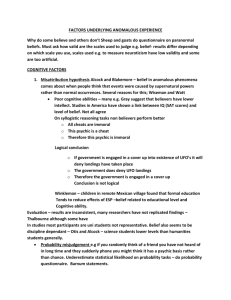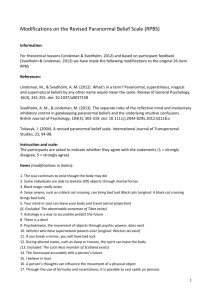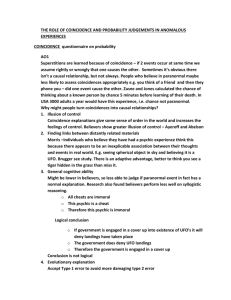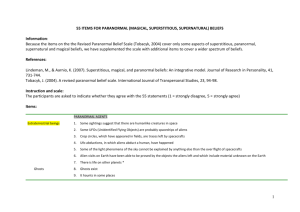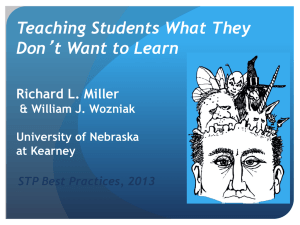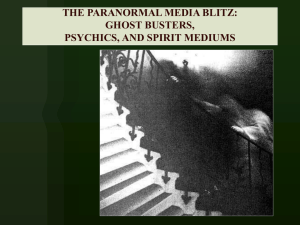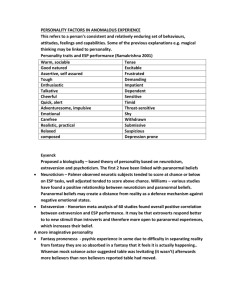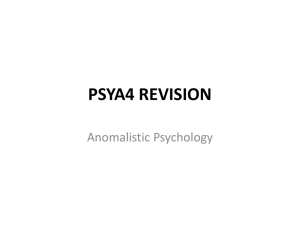Past paper answers
advertisement
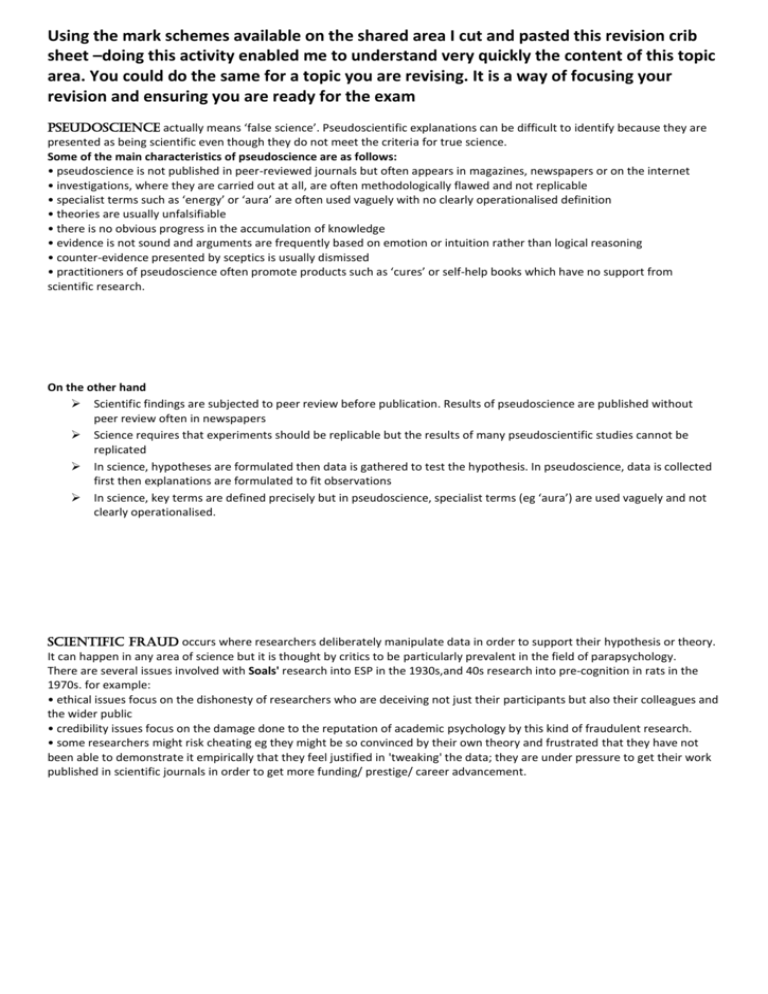
Using the mark schemes available on the shared area I cut and pasted this revision crib sheet –doing this activity enabled me to understand very quickly the content of this topic area. You could do the same for a topic you are revising. It is a way of focusing your revision and ensuring you are ready for the exam Pseudoscience actually means ‘false science’. Pseudoscientific explanations can be difficult to identify because they are presented as being scientific even though they do not meet the criteria for true science. Some of the main characteristics of pseudoscience are as follows: • pseudoscience is not published in peer-reviewed journals but often appears in magazines, newspapers or on the internet • investigations, where they are carried out at all, are often methodologically flawed and not replicable • specialist terms such as ‘energy’ or ‘aura’ are often used vaguely with no clearly operationalised definition • theories are usually unfalsifiable • there is no obvious progress in the accumulation of knowledge • evidence is not sound and arguments are frequently based on emotion or intuition rather than logical reasoning • counter-evidence presented by sceptics is usually dismissed • practitioners of pseudoscience often promote products such as ‘cures’ or self-help books which have no support from scientific research. On the other hand Scientific findings are subjected to peer review before publication. Results of pseudoscience are published without peer review often in newspapers Science requires that experiments should be replicable but the results of many pseudoscientific studies cannot be replicated In science, hypotheses are formulated then data is gathered to test the hypothesis. In pseudoscience, data is collected first then explanations are formulated to fit observations In science, key terms are defined precisely but in pseudoscience, specialist terms (eg ‘aura’) are used vaguely and not clearly operationalised. Scientific fraud occurs where researchers deliberately manipulate data in order to support their hypothesis or theory. It can happen in any area of science but it is thought by critics to be particularly prevalent in the field of parapsychology. There are several issues involved with Soals' research into ESP in the 1930s,and 40s research into pre-cognition in rats in the 1970s. for example: • ethical issues focus on the dishonesty of researchers who are deceiving not just their participants but also their colleagues and the wider public • credibility issues focus on the damage done to the reputation of academic psychology by this kind of fraudulent research. • some researchers might risk cheating eg they might be so convinced by their own theory and frustrated that they have not been able to demonstrate it empirically that they feel justified in 'tweaking' the data; they are under pressure to get their work published in scientific journals in order to get more funding/ prestige/ career advancement. Why do people believe though? Psychological explanations are based around the idea that humans have a deep-seated need to seek causality. This leads us to see causes for random events which are the product of chance. Basically, people have a poor understanding of probability. Intellectual ability: people who believe in psychic abilities often have reduced intellectual ability and do not appreciate the role of coincidence. Coincidence is where two or more events happen by chance to occur at the same time or in close succession leading to an assumption that they are linked. Probability misjudgement: people who believe in the paranormal are poorer at estimating chance and coincidence than nonbelievers. The law of truly large numbers: with a large enough sample, the most improbable things happen. Because we all dream at night, this is a sufficiently large sample to ensure that at some point someone’s dream will appear to come true. Since people believe that extreme events are unlikely to happen causality is misattributed to something paranormal. Subjective validation: this is a cognitive bias in which people tend to remember the affirming ‘hits’ and overlook the far more frequent ‘misses’. Locus of control: may be related to certain kinds of paranormal belief, eg an external locus of control is associated with more superstitious belief and behaviour. Some aspects of paranormal belief do not seem to be related to locus of control at all however, Extroversion – introversion: extroverts generally have higher beliefs in ESP (Honorton et al 1998) Neuroticism – significant correlations between neuroticism and superstition have been found (eg Wiseman 2004) but other studies (eg MacDonald 2000) have contradicted this. Sensation seeking personality traits: paranormal belief offers a source of excitement. Some research suggests that people with greater paranormal belief are more likely to score high on measures of sensation-seeking. (Kumar et al 1993) Creativity and fantasy proneness: Research has indicated a positive correlation with paranormal belief. Other research suggests that highly artistic people tend to have a greater belief in the paranormal and score higher on tests of ESP - positive correlation between creative personality traits and beliefs in paranormal (Gianotti et al 2001) Systematic errors in deductive reasoning • Weak probabilistic reasoning • Biased concepts of randomness and meaningfulness • Memory bias for apparent paranormal experiences • Non-conscious processing of information which is later perceived to stem from precognition • Heightened sensitivity to environmental cues (eg changes in light, temperature, magnetic field etc) which might then be interpreted as paranormal phenomena • Perceptual bias eg misinterpreting stimuli seen in less than optimal viewing conditions It has even been suggested that ‘believers’ have over-activated right hemisphere processing compared to non-believers. Tobacyk et al (1988) have found a link between locus of control, superstitious behaviour and paranormal belief; Kumar et al (1993) found that sensation seeking personality scores were related to both a greater paranormal belief and a greater number of reported paranormal experiences; Gianotti et al (2001) found a high positive correlation between belief in the paranormal and creative personality (specifically, they found that people with high paranormal belief generated more original words in word task than other people). Fantasy proneness has been shown to correlate with paranormal belief (e.g. Irwin, 1991). Ramakrishna (2001), in a study of adolescents, found a link between certain personality characteristics and good performance on ESP tasks. Also, extroverts scored better at ESP than introverts. A number of studies have shown a link between schizotypy and paranormal beliefs (eg Goulding 2005). Poor reasoning skills There is considerable evidence (eg review by French (1992) that belief in the paranormal is higher in people with some sort of 'cognitive deficit'. One particular cognitive ability to attract attention in this context is syllogistic reasoning (eg Wierzerbiki (1985)). Although, findings are mixed, there has been general support for the idea that people who believe in the paranormal do worse on such tasks than other people. There is also some evidence that believers are less familiar with scientific principles and are less able to see the flaws in poorly designed experiments than others. There are many cognitive factors for example, confirmation bias, causal attributions, false probability. Can you think of any more? So why do some people not believe? Some people are less vulnerable to anomalistic beliefs in this scenario. For example, some people do not suffer from fantasy proneness where they muddle up reality and imagination; they probably have good reasoning skills (particularly on syllogistic reasoning tasks); they may also have a good understanding of scientific principles and understands how to differentiate between 'good' and 'bad' science; they are probably able to assess the likelihood of coincidences accurately; they probably have an internal locus of control and believes that they are responsible for outcomes like exam success Magical thinking refers to a type of reasoning in which causal relationships are found between events and/or objects which are not logically related, and it is intrinsically linked to superstitious behaviour. One of the most fundamental explanations of magical thinking is the law of contagion proposed originally by James Frazer. This is the idea that an object which has been in contact with a person comes to possess the ‘essence’ of that individual. This would help to explain why people are unwilling to buy houses where a tragedy has happened. The law of contagion has been demonstrated experimentally (eg Nemeroff and Rozin 1994). Why do people develop magical thinking? Reduction of anxiety: magical thinking is prevalent in times and places of uncertainty and danger. Malinowski argued that magical thinking helps people reduce their anxiety, to cope with uncertainty and gives a sense of control over an unpredictable world. This would help to explain why people in dangerous occupations (such as deep sea fishing) are likely to resort to magical thinking. It has been demonstrated that magical thinking is more prevalent in war zones (Keinan 1994). It has also been demonstrated experimentally with pre-operative patients awaiting major surgery (Shrimali and Broota 1987). There are other explanations of magical thinking which could be applied here, for example magical thinking is more prevalent in some cultures than others, especially those where war is common (Blaisdell and Denniston 2002). Mediumship - Psychic mediumship refers to the process in which a medium contacts a deceased person, on behalf of a ‘sitter’, generally in a trance state. There are a range of explanations for psychic mediumship. Generally, biological explanations seek underlying physiological correlates of trance states whereas cognitive explanations focus on the cognitive tendencies of believers and the techniques used by mediums to convince them: Biological explanations focus on mediumship as an altered state of consciousness and explore the psychophysiology behind trance states. Emphasis is placed on the role played by the limbic system in the trance like state Personality/mental health explanations: some researchers argue that mediumship an extreme form of dissociative identity disorder, eg Braude (1995) Cognitive explanations focus on the ways that believers interpret the information provided by psychic mediums. They assume that believers find connections between unrelated events and see patterns where none really exist. This is sometimes known as the tendency to make the Type I error (eg Brugger, 2001) Roe (1991) focusses on strategies employed by mediums (often called cold reading) to convince sitters about the validity of information provided to them Evaluation There is some evidence to support the claim that mediumship is an altered state of consciousness, eg Winkelman (2000) argues that the trance state is characterised by a shift toward right hemispheric dominance, along with a dominance of the parasympathetic nervous system Studies show that biological indicators are not consistent across mediums Cognitive explanations point to the prevalence of ‘Barnum’ statements used by mediums which can apply to most people Roe (1991) has provided extensive evidence of the hierarchy of strategies used by mediums including cold reading (using non-verbal information) and warm reading (direct ‘ fishing’ for information) Studies comparing DID and mediumship have found superficial similarities only: generally mediums display good mental health, in contrast to those suffering from DID (Riesel, 2003). There are some impressive scientific trials of mediumship, for example Beischel and Schwartz (2007) which demonstrated mediumship using a triple blind procedure The basic Ganzfeld ESP procedure. The sensory deprivation of a subject (the receiver) via headphones with white noise, translucent goggles or halved ping-pong balls over the eyes The sender, who is in another room, chooses one of a selection of (usually) 4 images to send telepathically. The choice of image to send should be random The receiver attempts to ‘read’ the image At the end of the session the receiver is shown a set of images and asked to select the target image from several or to describe the image If the receiver is really able to read the thoughts of others, he/she should be able to pick the target at greater than chance level over several trials Auto-Ganzfeld procedure has greater control, including sound-proofing and computerised selection of images. Evaluation Issues 1. possible cheating and lack of control in early studies eg sensory leakage, insecure storage of images 2. possible researcher bias eg sceptical researchers v psi believers can influence the amount of elaboration by the receiver 3. influence of the receivers’ beliefs (the sheep-goat effect) Methodological issues with research Paranormal explanations are based mainly on anecdote. There are issues such as non-falsifiability and the nature of scientific investigation eg generating testable hypotheses. Consider the strengths/weaknesses of methods used (including case studies) Possible issues/debates/approaches include cultural issues; reliability/validity; reductionism. There is no obvious way of testing belief in the paranormal There is some evidence that the beliefs of the experimenter can be important in influencing the outcome of studies into the paranormal it is, therefore, important that measuring tools are independently assessed to apply a scientific approach to investigate an areas whose scientific status has been questioned. A wide range of issues include, the problem of experimental control, the role of the experimenter (for, example, the problem of experimenter bias or psi inhibition), differences in analysis and reporting. Methodological issues involved in the study of psychokinesis. Psychokinesis refers to the (disputed) ability to move objects by the mind. PK was initially accessed via eye only (macro PK) then by the ability to influence the fall of dice. Latterly, it has been superseded by micro PK in which technology is used. Relevant methodological issues include: • bias/sleight of hand in dice rolling studies • experimenter bias in recording macro PK results • lack of validity of micro PK studies • problems of replication in all of the above. Psychic healing. Some studies have demonstrated significant benefits from psychic healing, whereas others have shown a lack of benefit: • Krieger (2000) found higher haemoglobin levels in a group who had received psychic healing than a control group. • Bener’s (2000) meta-analysis identified positive effects in 197 studies of psychic healers. • Keller et al (1986) double blind trial found significant benefits to tension headaches. Tang (1998) suggests that psychic healing increases relaxation and activates self-healing. contradictory findings of studies on healing • lack of controlled, double blind trials • use of small volunteer samples • ethical issues (e.g. vulnerability, exploitation of those seeking healing).
